Understanding the cost of dental treatment can often feel like navigating a maze. When it comes to fillings, the price can vary significantly depending on several factors. This article aims to provide a clear and comprehensive guide to the costs associated with fillings at private dental practices in the UK, empowering you to make informed decisions about your oral health.
Factors Influencing Filling Prices at Private Dentists
Much like a bespoke suit, the cost of a filling is influenced by its characteristics and the expertise involved in its creation. Here’s a breakdown of the key factors:
- Type of Filling Material:
Think of filling materials like choosing the right fabric for your clothes. Each material has its properties and price point:
- Amalgam Fillings: These are the traditional silver-coloured fillings, often the most affordable option. They are durable and long-lasting, making them a cost-effective choice for back teeth.
- Composite Fillings: These tooth-coloured fillings are aesthetically pleasing and blend seamlessly with your natural teeth. They are a popular choice for visible areas and can be more expensive than amalgam fillings.
- Gold Fillings: Known for their strength and durability, gold fillings are a premium option. They are highly resistant to wear and tear but come with a significantly higher cost.
- Ceramic/Porcelain Fillings: These offer excellent aesthetics and durability, comparable to gold. They are biocompatible and a good choice for those with metal sensitivities, but they are also a high-end option.
- Glass Ionomer Fillings: These are often used for children’s teeth or fillings below the gum line. They release fluoride, which helps to protect the tooth from further decay and is generally a more affordable option.

- Size and Complexity of the Filling:
Imagine repairing a small tear in your shirt versus patching up a large hole. Similarly, the size and complexity of a filling directly impact its cost. A small filling on a single surface will be less expensive than a large filling that spans multiple surfaces or requires intricate shaping.
- Tooth Location:
Accessing and treating back teeth, like molars, can be more challenging than front teeth. This increased difficulty can sometimes translate to a higher cost for fillings in those areas. Think of it like plumbing – fixing a leak in an easily accessible pipe is simpler and cheaper than repairing one hidden deep within a wall.
- Dentist’s Experience and Location:
Just as a renowned tailor might charge more for their expertise, a highly experienced dentist in a prime location may have higher fees. Practices in affluent areas like London or Edinburgh might have higher overheads, which can influence their pricing.
- Additional Procedures:
Sometimes, a filling might require additional procedures, such as X-rays to assess the extent of the decay, anaesthesia to ensure your comfort, or treatment for any underlying infection. These additional procedures will contribute to the overall cost of your treatment.
What is the Average Cost of Fillings in the UK?
While it’s impossible to give an exact figure without a consultation, here’s a general idea of what you might expect to pay for fillings at a private dentist in the UK:
- Basic Filling (Amalgam): £60 – £120
- Mid-Range Filling (Composite): £150 – £250
- High-End Filling (Gold/Ceramic): £250 – £400+
Remember that these are just estimates, and the actual cost will depend on the factors mentioned earlier. It’s always best to schedule a consultation with your dentist to get a personalised quote.
How Does Dental Insurance Affect Filling Costs?
Dental insurance can help reduce your out-of-pocket expenses for fillings. Most dental insurance plans cover a percentage of the cost of fillings, typically ranging from 50% to 80%. However, it’s crucial to understand your policy’s specifics:
- Annual Limits: Most plans have an annual limit on how much they will pay towards dental treatment.
- Deductibles: You may need to pay a deductible before your insurance coverage kicks in.
- Co-pays: You might be responsible for a co-pay, a fixed amount you pay for each treatment.
- In-Network Dentists: To maximise your benefits, choose a dentist within your insurance network.
Exploring Payment Options for Dental Fillings
Private dentists typically offer various payment options to make treatment more accessible:
- Dental Insurance: As discussed above, utilising your dental insurance can significantly reduce your costs.
- Out-of-Pocket: If you don’t have insurance or your treatment isn’t fully covered, you can pay for your filling directly.
- Payment Plans: Many dentists offer flexible payment plans, allowing you to spread the cost over several months.
- Dental Discount Plans: These plans offer discounted rates for dental treatments at participating dentists. While not insurance, they can be a cost-effective alternative.
Tips for Saving Money on Dental Fillings
Prevention is always better than cure, especially when it comes to your oral health. Here are some ways to save money on fillings:
- Prioritise Preventive Care: Regular checkups and cleanings can help identify and address potential issues before they escalate into needing fillings. Think of it like servicing your car regularly to prevent costly breakdowns.
- Maintain Excellent Oral Hygiene: Brushing twice a day, flossing daily, and limiting sugary foods and drinks can significantly reduce your risk of developing cavities.
- Shop Around: Don’t hesitate to get quotes from multiple dentists before making a decision. Prices can vary between practices, so it pays to compare.
- Enquire About Specials or Discounts: Some dentists offer discounts for new patients, seniors, or cash payments.

Beyond Fillings: Alternatives for Extensive Damage
In cases of extensive tooth damage, your dentist might recommend alternatives to fillings, such as:
- Inlays and Onlays: These are custom-made fillings that are created in a lab and bonded to the tooth. They are often used for larger cavities or when more of the tooth structure needs to be restored.
- Crowns: These are caps that cover the entire visible portion of the tooth. They are used to restore severely damaged teeth or those that have undergone root canal treatment.
Your dentist will assess your individual needs and recommend the most appropriate treatment option.
Taking Control of Your Oral Health
Understanding the factors that influence filling costs and exploring available payment options can empower you to make informed decisions about your dental care. Remember, maintaining good oral hygiene and attending regular checkups are the best ways to prevent the need for fillings in the first place.
Disclaimer: The prices provided in this article are estimates and can vary significantly depending on individual circumstances and the specific dental practice. It’s always best to schedule a consultation with your dentist for a personalised quote.













